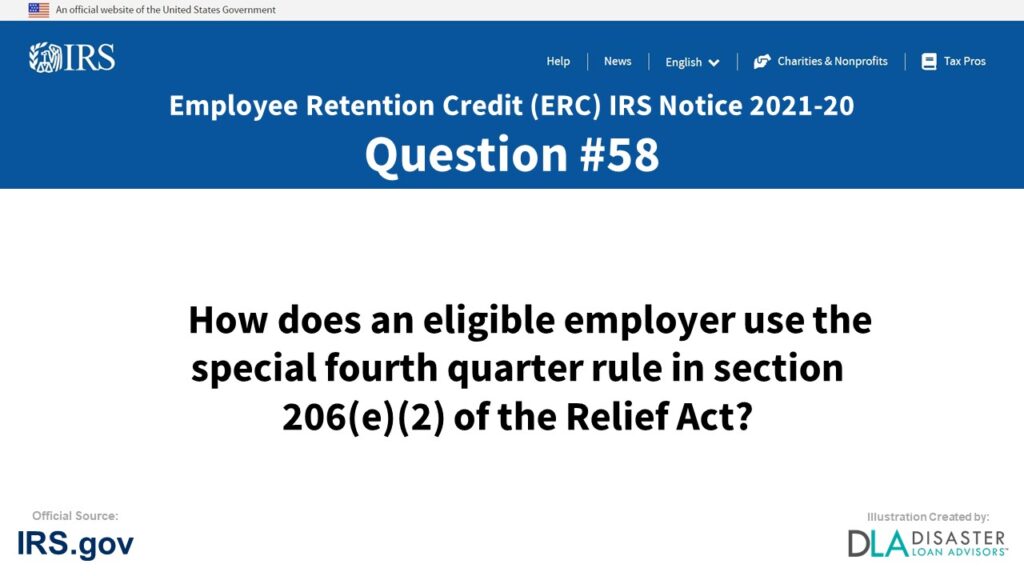
Question #58
How does an eligible employer use the special fourth quarter rule in section 206(e)(2) of the Relief Act?:
Found under the J. Claiming the Employee Retention Credit section of the Employee Retention Credit (ERC) IRS Notice 2021-20 with updated guidance to help business owners follow the current ERC rules.
The answer to question #58, How does an eligible employer use the special fourth quarter rule in section 206(e)(2) of the Relief Act?, can be found below.
ERC IRS Notice 2021-20 Question #58:
J. Claiming the Employee Retention Credit
How does an eligible employer use the special fourth quarter rule in section 206(e)(2) of the Relief Act?
If an eligible employer received a PPP loan, and reported qualified wages paid in the second and/or third quarter of 2020 as payroll costs on its PPP Loan Forgiveness Application, but the loan was not forgiven by reason of a decision under section 7A(g) of the Small Business Act, then the eligible employer may take the qualified wages reported as payroll costs on its PPP Loan Forgiveness Application into account for purposes of the employee retention credit and claim the employee retention credit on those qualified wages on the fourth quarter Form 941. An eligible employer may also claim the employee retention credit on the fourth quarter Form 941 with respect to any qualified health plan expenses paid in the second and/or third quarter of 2020, for which the employer had not claimed the employee retention credit.
If an eligible employer elects to use this special fourth quarter rule, the eligible employer should add the employee retention credit attributable to the second and/or third quarter qualified wages and qualified health plan expenses on line 11c or line 13d (as relevant) of the original fourth quarter Form 941 (along with any other employee retention credit for qualified wages paid in the fourth quarter). The eligible employer should also:
• Include the amount of these qualified wages paid during the second and/or third quarter (excluding qualified health plan expenses) on line 21 of the original fourth quarter Form 941 (along with any qualified wages paid in the fourth quarter);
• Enter the same amount on Worksheet 1, Step 3, line 3a;
• Include the amount of these qualified health plan expenses from the second and/or third quarter on line 22 of the fourth quarter Form 941 (along with any qualified health plan expenses for the fourth quarter);
• Enter the same amount on Worksheet 1, Step 3, line 3b.
Eligible employers are not required to use this special fourth quarter rule. Eligible employers may instead choose the regular process of making an interest-free adjustment or filing a claim for refund for the appropriate quarter to which the additional employee retention credit relates using Form 941-X for the previously filed Form 941.
For more information about the Employee Retention Credit (ERC) IRS Notice 2021-20, visit the Internal Revenue Service (IRS) Department of the Treasury, official IRS.gov tax website.
Conclusion and Summary on How does an eligible employer use the special fourth quarter rule in section 206(e)(2) of the Relief Act? – #58 ERC IRS Notice 2021-20
The answer to Question #58: “How does an eligible employer use the special fourth quarter rule in section 206(e)(2) of the Relief Act?” was answered in detail above. It was found under section “J. Claiming the Employee Retention Credit” in IRS Notice 2021-20.
Leave a comment below if you have further questions on the Employee Retention Credit (ERC) or for clarifications on How does an eligible employer use the special fourth quarter rule in section 206(e)(2) of the Relief Act?
Employee Retention Tax Credit (ERTC): Expert Assistance to Claim Your Business ERC Credit
Up to a $26,000 ERC Refund from the IRS for Each Employee
Disaster Loan Advisors can assist your business with the complex and confusing Employee Retention Credit (ERC), Form 941-X, and the Employee Retention Tax Credit (ERTC) program.
Depending on eligibility, business owners and companies can receive up to $26,000 per employee based on the number of W2 employees you had on the payroll in 2020 and 2021.
The ERC / ERTC Tax Credit Program is a valuable IRS tax credit you can claim. This is money you have already paid to the IRS in payroll taxes for your W2 employees.
We DO NOT charge a percentage (%) of your ERC Refund like some companies are charging. Some ERC firms out there are charging upwards of 15% to 35% of your ERC refund!
Our professional ERC fee and pricing structure is very reasonable in comparison.
If you are looking for an ERC Company that believes in providing professional ERC Services and value, in exchange for a fair, reasonable, and ethical fee for the amount of work required, Disaster Loan Advisors is a good fit for you.
Schedule Your Free Employee Retention Credit Consultation to see what amount of employee retention tax credit your company qualifies for.
Cover Image Credit: Irs.gov / IRS Notice 2021-20 / Disaster Loan Advisors.
